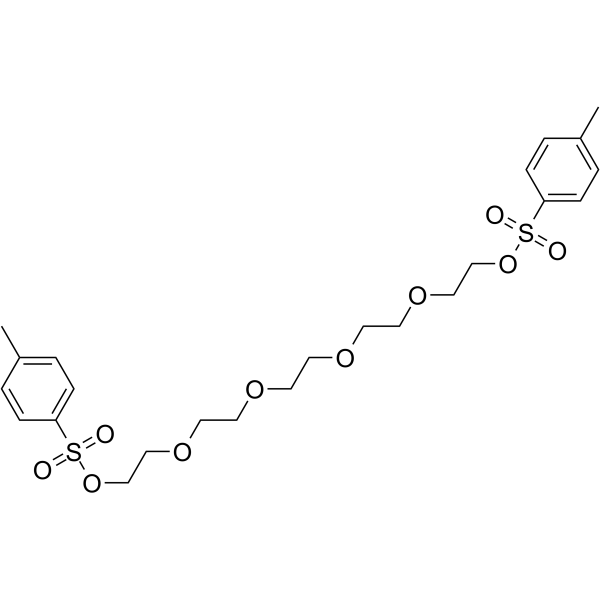
Pentaethylene glycol di(p-toluenesulfonate)
CAS No. 41024-91-3
Pentaethylene glycol di(p-toluenesulfonate)( Penta(ethylene glycol) bis(p-toluenesulfonate) | Bis-Tos-PEG5 )
Catalog No. M26999 CAS No. 41024-91-3
Pentaethylene glycol di(p-toluenesulfonate) is a PEG-based PROTAC linker that can be used in the synthesis of PROTACs.
Purity : >98% (HPLC)
 COA
COA
 Datasheet
Datasheet
 HNMR
HNMR
 HPLC
HPLC
 MSDS
MSDS
 Handing Instructions
Handing Instructions
| Size | Price / USD | Stock | Quantity |
| 500MG | 35 | In Stock |


|
| 1G | Get Quote | In Stock |


|
Biological Information
-
Product NamePentaethylene glycol di(p-toluenesulfonate)
-
NoteResearch use only, not for human use.
-
Brief DescriptionPentaethylene glycol di(p-toluenesulfonate) is a PEG-based PROTAC linker that can be used in the synthesis of PROTACs.
-
DescriptionPentaethylene glycol di(p-toluenesulfonate) is a PEG-based PROTAC linker that can be used in the synthesis of PROTACs.(In Vitro):PROTACs contain two different ligands connected by a linker; one is a ligand for an E3 ubiquitin ligase and the other is for the target protein. PROTACs exploit the intracellular ubiquitin-proteasome system to selectively degrade target proteins.
-
In VitroPROTACs contain two different ligands connected by a linker; one is a ligand for an E3 ubiquitin ligase and the other is for the target protein. PROTACs exploit the intracellular ubiquitin-proteasome system to selectively degrade target proteins.
-
In Vivo——
-
SynonymsPenta(ethylene glycol) bis(p-toluenesulfonate) | Bis-Tos-PEG5
-
PathwayOthers
-
TargetOther Targets
-
Recptor——
-
Research Area——
-
Indication——
Chemical Information
-
CAS Number41024-91-3
-
Formula Weight546.65
-
Molecular FormulaC24H34O10S2
-
Purity>98% (HPLC)
-
Solubility——
-
SMILESCc1ccc(cc1)S(=O)(=O)OCCOCCOCCOCCOCCOS(=O)(=O)c1ccc(C)cc1
-
Chemical Name——
Shipping & Storage Information
-
Storage(-20℃)
-
ShippingWith Ice Pack
-
Stability≥ 2 years
Reference
1.Takatsuki S, Nemoto S, Sasaki K, Toyoda M. [Determination of ethychlozate and its degradation product in fruits by HPLC and LC/MS]. Shokuhin Eiseigaku Zasshi. 2002 Feb;43(1):30-4. Japanese.
molnova catalog



related products
-
Cyclic MKEY TFA (934...
Cyclic MKEY TFA is a synthetic cyclic peptide inhibitor of CXCL4-CCL5 heterodimer formation, which protects against atherosclerosis and aortic aneurysm formation by mediating inflammation.
-
NIBR-0213
NIBR-0213, a potent and selective S1P(1) antagonist, has efficacy in experimental autoimmune encephalomyelitis.
-
N-Oxalylglycine
N-Oxalylglycine is a cell permeable inhibitor of α-ketoglutarate-dependent enzymes.



 Cart
Cart
 sales@molnova.com
sales@molnova.com


